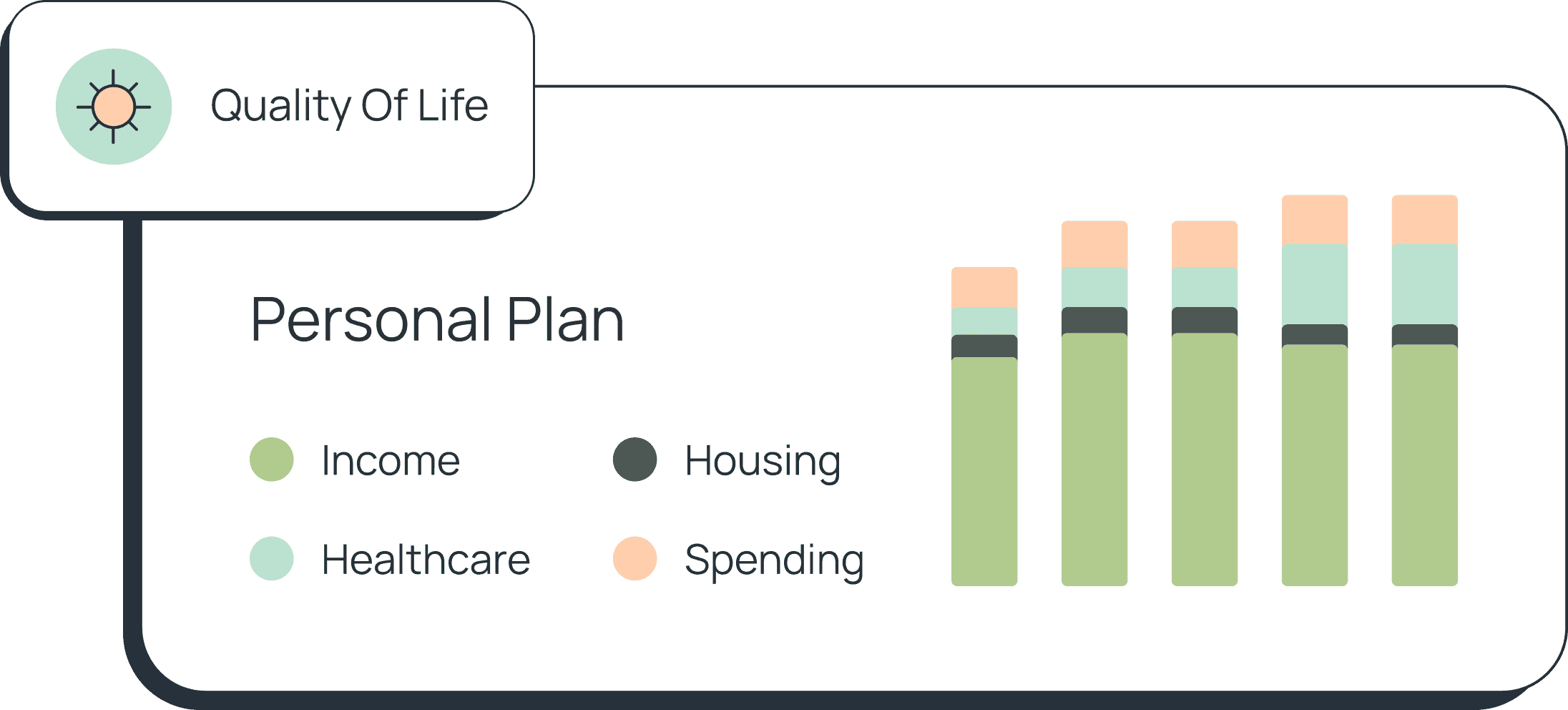Pensions
Picking the right pension payout plan can have a big impact on retirement, and unfortunately, it can also be complicated and confusing.

R. Tyler End, CFP®
•
Published February 17th, 2020
•
Updated December 13th, 2022
Table of Contents
Key Takeaways
Pensions can provide guaranteed income for the rest of your life, if you choose the right payout option.
There are typically five different payout options available to retirees.
While it may be tempting to take a lump sum, we suggest choosing an annuity distribution (monthly payments).
For those that have them, pensions are a powerful retirement tool. Depending on the payout option you choose, pensions can provide a guaranteed income for the rest of your life, and combined with Social Security benefits, could cover most of your expenses through retirement. Picking the right payout option can have a big impact on your retirement, and unfortunately, it can also be complicated and confusing. In this article, we break down the five options for pension payouts, how they work, and how to choose.
What are pensions?
First things first, a bit on how pensions work. Pensions are a type of retirement plan, offered by employers, called a “defined-benefit plan.” Depending on how long you’ve worked for your employer, you’ll be guaranteed a certain amount of monthly income in retirement. The onus is your employer to make sure that their pension fund is invested correctly and can provide that guaranteed income for as long as you may live.
Compare that to a 401(k), which is what’s known as a “defined-contribution plan.” With 401(k)s, you own the retirement account, and your employer can choose to give a specific contribution to that account. You can choose your own investments in the account and there’s no guaranteed minimum benefit. Because you can control the investments in your 401(k) account, you are also subject to investment risks, so you may want to consult a Certified Financial Planner or Registered Investment Advisor on your 401(k) investment strategy.
With both pensions and traditional 401(k)s, you’ll owe income taxes on any payouts or distributions.
If you have a pension, you’ll usually receive a pension plan statement from your employer on an annual basis. Your statement will tell you what your monthly benefit would be if you left the company right now, as well as how much it would be if you stayed until you retired. It will also tell you your vesting percentage – most companies require you to work for a certain number of years in order to receive 100% of your pension benefits.
Most Americans do not have pensions. According to data from the Bureau of Labor Statistics, just 22% of workers participate in a pension plan. The majority of those people work in state or local government – 77% of government workers participated in a pension plan versus 13% of private-sector workers.
In some states, a government pension may replace Social Security for certain government workers, such as teachers.
Most private-sector companies have switched from offering pensions to 401(k)s, as it is cheaper for them. Just last year, General Electric froze their pension program after closing it to new employees in 2012. A few big companies still offering pensions: Coca-Cola, ExxonMobile, and General Mills.
The 5 pension payout options for retirees
Typically, new retirees will have five different pension payout options available to them. Which is the best for you? Compare below:
Lump sum payment
While most of the payout options available to pensioners are annuity distributions (monthly payments), you can choose to take a lump sum payment instead. Some pensioners are attracted to the idea of getting all of the money they’re owed at once, and there are some benefits, chief of which is that you can control where that money is invested. You can roll your pension into an IRA, for example (which also means you don’t owe any money on your pension payout until you take distributions from the IRA).
The biggest and most common risk with taking a lump sum payment is that you outlive your savings. Many people underestimate how long they’ll live in retirement, as well as how crucial having a guaranteed source of income will be in their old age. We would suggest in most cases that you avoid a lump sum payment and choose one of the annuity options instead.
Single life plan
Of all the annuity options, the single life plan is typically your highest monthly payout, which you will receive for the rest of your life. The big trade-off is that there are no benefits for a surviving spouse – when you die, the payments end. If you’re unmarried, this is typically the best choice.
Joint and survivor plan
If you choose a joint and survivor plan, you’ll get a lower monthly payout than a single life plan, but instead of payments stopping when you die, your beneficiary (usually a spouse, but it can be a child or anyone else you choose) will receive a percentage of your benefits after your death. Options range from 50 to 100% of your benefits, with higher percentages usually corresponding to lower monthly payments. This is typically the best option for individuals who want to guarantee that their spouse has a lifetime source of income when they pass.
Many people with pensions don't realize that their spouse or child could continue to receive benefits after they die. If you have a pension, make sure to discuss these payment options to see if they fit with your family's overall financial plan.
Period-certain plan
Period-certain plans are a variation on the above two payout plans. Period-certain plans have a monthly payout for your entire life, with a guaranteed minimum number of years that payouts will occur. For example, a period-certain plan could have a minimum of ten years of payouts. If you died after five years, payouts to a beneficiary would continue for another five years. If it’s a joint and survivor period-certain plan, a beneficiary will continue getting payouts even if both you and your spouse died.
You can think of a period-certain plan almost like a small life insurance policy; period-certain plans can be a good option if you’re still financially supporting your kids, as it can provide income for them until they become financially independent.
Social Security income-leveling plan
Social Security income-leveling plans can be a good option for someone taking an early retirement. Income-leveling plans start with larger monthly payments, which get reduced once you start taking Social Security. The end result is that you have a level amount of income throughout your entire retirement. The major benefit of taking this plan is that allows those taking an early retirement to make the most out of their Social Security benefits by waiting to take them, instead of taking them too early in order to make ends meet in the short-term.
Indexed versus level payout
Before you take your payout, check to see if your pension has an option for indexed payouts. Indexed payouts increase to adjust for inflation, similar to Social Security, while level payouts stay the same for your entire retirement.
Bottom Line
No one knows how long they’re going to live, and the number one risk facing retirees is that they outlive their savings. If you’re lucky enough to have a pension, taking a monthly payout is an excellent choice – it’s a guaranteed source of income that, along with Social Security, can help you make ends meet for your entire retirement. Talk to a Certified Financial Planner today for guidance on which payout option makes the most sense for you.
Share this advice

Tyler is a Certified Financial Planner® and CEO & Co-Founder at Retirable, the retirement peace of mind platform. Tyler has nearly 15 years of experience at leading companies in the wealth management and insurance industries. Before Retirable, Tyler worked as Head of Operations Expansion at PolicyGenius, expanding the company’s reach into new products — turning PolicyGenius into an industry-leading disability and P&C insurance distributor. Before working at PolicyGenius, Tyler worked as Wealth Management Advisor at prominent financial services organizations.
As an advisor, Tyler played an integral role in helping clients define goals, achieve financial independence and retire with peace of mind. Through this work, Tyler has helped hundreds of thousands of people get the financial planning and insurance advice they need to succeed. Since founding Retirable, Tyler’s innovative approach to retirement planning has been featured in publications such as Forbes, Fortune, U.S. News & World Report, and more.
Pension Basics
Pension Considerations
Pension Payout Options
Share this advice

Tyler is a Certified Financial Planner® and CEO & Co-Founder at Retirable, the retirement peace of mind platform. Tyler has nearly 15 years of experience at leading companies in the wealth management and insurance industries. Before Retirable, Tyler worked as Head of Operations Expansion at PolicyGenius, expanding the company’s reach into new products — turning PolicyGenius into an industry-leading disability and P&C insurance distributor. Before working at PolicyGenius, Tyler worked as Wealth Management Advisor at prominent financial services organizations.
As an advisor, Tyler played an integral role in helping clients define goals, achieve financial independence and retire with peace of mind. Through this work, Tyler has helped hundreds of thousands of people get the financial planning and insurance advice they need to succeed. Since founding Retirable, Tyler’s innovative approach to retirement planning has been featured in publications such as Forbes, Fortune, U.S. News & World Report, and more.
Free Retirement Consultation
Still have questions about how to properly plan for retirement? Speak with a licensed fiduciary for free.




